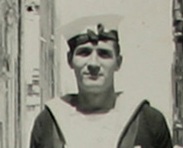Written by Rus Slater (son)
Telegraphist Albert James Slater. (Jim or “Lofty”)
Albert Slater
Jim Slater joined the Navy as a Boy in 1936 and served throughout the Navy until 1953 when he left and went to civilian employment.
He took part in thirteen Arctic Convoys aboard HMS Meteor, making seven trips to Russia.
He also took part in the Battle of the Narvik, aboard HMS Warspite, and as the Harbourmaster’s telegraphist during the raid on St Nazaire. He went ashore on occupied Crete as a Naval Gunfire Support officer’s radio operator, and was part of the prize crew on a captured Italian warship.
He didn’t talk much at all about his wartime experiences, my mother told me, after he had died, that throughout the 50s and 60s he still had nightmares. He never joined any veterans’ associations and only wore his war medals once; when he went to a “Fathers’ Mess Dinner” at the Royal Military Academy Sandhurst just before his younger son’s Commissioning. At that event he was actually quite proud to see that he had more medals than any of the other fathers or serving officers present.
There were really only a few snippets of his experience that he ever mentioned about the Convoys;
Tobacco was so scarce that they used to dry out the used tea-leaves from the mess-deck and either put it in a pipe or try to roll it in cigarette paper. In the latter case you had to be extremely careful that it didn’t simply all pour out whilst being lit or smoked.
His off duty action station was as a loader on one of the pom-pom anti aircraft guns. His role was to take the 2lb shells from the ammunition locker and put them into the feed hopper on top of the gun’s breach. The gun-layer, wanting to avoid any stoppages wanted the shells “greased” before they were put into the gun. The crew had a big bucket of waste mixed cooking fat from the galley and each shell was quickly plunged into this before being added to the hopper. He said that they didn’t get stoppages but the stench was enough to choke you!
On one occasion he was sitting on the open metal steps in his mess doing his washing when he came to the start of his watch. As he left the mess one of his messmates took his place on the steps to do his dhobi. A short time into the watch the convoy came under air-attack and the boat took some damage. After the end of action-stations there was a piped call known as “come and recognise your mess mates”. On returning to the mess he found that the fellow who had taken his place had been blown by blast straight through the metal stairs and was literally in pieces on the other side.
After his last convoy he had a short period of home leave. He visited his then fiancée whose parental home was in Battersea. As he walked up to the front door he was assaulted by the next door neighbour. She had heard that he had just completed his thirteenth Convoy, whereas her husband was a merchant sailor who had just been killed on his first trip to Archangel.
Jim Slater later married his fiancée, Margaret Bennison, a WREN who he had met at Antony House in Plymouth. Their marriage licence has the unusual inscription in manuscript “St George’s Church Battersea, owing to the destruction of St Andrew’s by enemy action”.
After leaving the Navy he joined a small private company called “The Diplomatic Wireless Service”. This did exactly what it said on the tin; it provided radio communication services to the Foreign and Commonwealth Office. Shortly after he joined the company was absorbed into the F&CO and so he returned to government service. He served in India around the time of independence, Czechoslovakia, Bahrain, The Soviet Union, Swaziland, Spain, Iraq, The People’s Republic of China, when the Mao-era ended and Libya during the Kaddafi troubles. He accompanied Prime Minister Harold Wilson as his personal communication officer on HMS Tiger during the Rhodesia UDI talks.
He was awarded an MBE shortly before his retirement.
He died in November 1996 after a short battle with Alzheimer’s.
He was survived by his widow, a daughter and two sons but lost his younger daughter in 1993 to a brain tumour.


